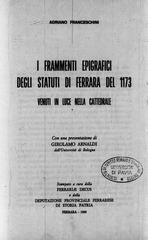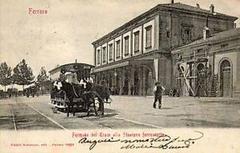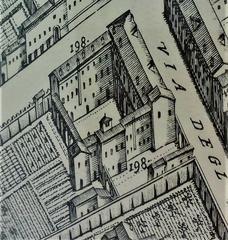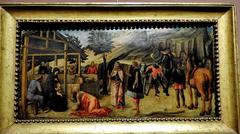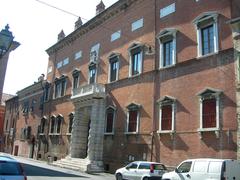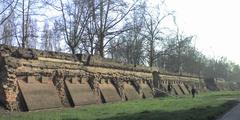Baluardo di San Pietro: Visiting Hours, Tickets, and In-Depth Historical Guide
Date: 03/07/2025
Introduction
The Baluardo di San Pietro, nestled within the UNESCO-listed city walls of Ferrara, Italy, stands as a remarkable testament to Renaissance military engineering and the urban vision of the Este dynasty. As part of the city’s extensive fortifications, this bastion not only played a critical defensive role but now serves as a vibrant public space, integrating Ferrara’s rich history with its contemporary urban life. This guide provides comprehensive, up-to-date information on visiting hours, ticketing, accessibility, guided tours, and nearby attractions—helping you plan a memorable visit to one of Ferrara’s most iconic historical sites (Comune di Ferrara, Ferrara Terra e Acqua, UNESCO World Heritage Centre).
Table of Contents
- Historical and Architectural Significance
- Urban Context and Green Spaces
- Practical Visiting Information
- Best Times to Visit and Events
- Suggested Itineraries & Nearby Attractions
- Photography, Tips, and Responsible Tourism
- Frequently Asked Questions (FAQ)
- Conclusion and Call to Action
- References and Further Reading
Historical and Architectural Significance
Constructed between the late 15th and early 16th centuries during the Este family’s “Addizione Erculea,” the Baluardo di San Pietro exemplifies the transition from medieval walls to innovative Renaissance bastioned fortifications. Designed for artillery defense, its angular, polygonal shape and thick brick walls offered strategic advantages during sieges, allowing defenders to cover the adjacent walls with crossfire while withstanding cannon bombardment.
The bastion’s construction was part of Ferrara’s transformation under architect Biagio Rossetti, who reimagined the city’s urban and defensive layout. Over the centuries, the Baluardo di San Pietro underwent various modifications to adapt to changing military technology but retained much of its Renaissance character. Today, it stands as a tangible link to Ferrara’s military past and a striking example of Renaissance urban planning (Ferrara Terra e Acqua, UNESCO World Heritage Centre).
Urban Context and Green Spaces
Strategically located on Ferrara’s northern walls, the Baluardo di San Pietro is now enveloped by lush parkland and is fully integrated into the city’s network of cycling and walking paths. The rampart’s “Ace of Spades” design, a hallmark of Renaissance military architecture, connects directly with the Po di Volano cycle path, encouraging sustainable mobility and inviting both locals and visitors to explore Ferrara’s historic and natural landscapes (Filomagazine).
The bastion serves as a vibrant social and cultural hub, frequently hosting community events, open-air exhibitions, and artistic performances. Its proximity to landmarks such as the Convent of Sant’Antonio in Polesine and the recently reopened Porta San Pietro enhances its cultural and urban significance.
Practical Visiting Information
Visiting Hours and Ticket Information
- Opening Hours: The Baluardo di San Pietro is an open-air site accessible year-round from dawn to dusk. There are no fixed closing times, and main paths are illuminated for safety in the evening.
- Tickets: Free admission for all visitors. Guided tours and special events may require advance booking and a fee (inferrara.it).
- Special Access: Interior spaces or exhibitions within the bastion, when available, follow specific schedules and may require tickets. Information on these can be found via the official Ferrara tourism website.
Accessibility and Facilities
- Paths: Main routes are paved and suitable for walking and cycling. Wheelchair users and those with limited mobility can access most areas from Via Baluardi, though some historic sections may be uneven or include steps (inferrara.it).
- Facilities: Seating, benches, and green spaces are available. Public restrooms are located at intervals along the city walls.
- Transport & Parking: Easily reached on foot or by bicycle from the city center, with public bus stops nearby. Parking is available outside the historic core.
Guided Tours and Interpretation
- Guided Tours: Offered seasonally by local associations and the municipal tourism office, especially during festivals or peak periods. Advance booking is recommended.
- Interpretive Panels: Installed throughout the site, with historical and architectural information available in Italian and, at primary points, in English.
- Digital Tools: The “Mura Aperte” project provides augmented reality experiences via smartphone, bringing historical reconstructions to life (inferrara.it).
Best Times to Visit and Events
- Seasonal Highlights: Spring (April–June) and autumn (September–October) offer the most pleasant weather and vibrant park scenery.
- Events: Major city festivals, such as the Ferrara Palio and Buskers Festival, often include special tours or activities at the bastion.
- Daily Life: Early mornings and late afternoons are ideal for photography, relaxation, and avoiding crowds.
Suggested Itineraries & Nearby Attractions
- Short Visit (30–45 minutes): Walk or cycle from Porta Paola to Baluardo di San Pietro, explore the bastion, and enjoy panoramic views.
- Half-Day Tour: Combine the bastion with nearby Baluardo di San Lorenzo, Santa Maria, and San Paolo, with a picnic in adjacent parks.
- Full-Day Exploration: Traverse the 9-kilometer circuit of Ferrara’s walls, stopping at key bastions, city gates, and the Castello Estense (thetravelfolk.com).
Nearby Attractions:
- Porta Paola: A striking 17th-century city gate with late Mannerist details.
- Castello Estense: Ferrara’s iconic moated castle in the city center.
- Parco Massari: Expansive public gardens perfect for post-exploration relaxation.
Photography, Tips, and Responsible Tourism
- Best Views: The bastion offers panoramic photo opportunities of Ferrara’s rooftops, walls, and green spaces. Sunrise and sunset are particularly scenic.
- Practical Tips: Wear sturdy shoes, carry water, and download maps or use GPS for navigation. Most signage is in Italian; translation apps can be helpful.
- Responsible Tourism: Stay on marked paths, respect heritage structures, and support local businesses. Dogs are welcome on a leash.
Frequently Asked Questions (FAQ)
Q: Is there an admission fee to visit Baluardo di San Pietro?
A: No, access to the rampart and surrounding parklands is free. Special tours or exhibitions may require tickets.
Q: What are the visiting hours?
A: The bastion is open from dawn to dusk year-round, with no fixed closing times.
Q: Is the site accessible for those with limited mobility?
A: Main paths are accessible with assistance; some historic areas may be uneven. Enter via Via Baluardi for the easiest access.
Q: Are guided tours available?
A: Yes, especially during festivals or peak seasons, offered by local associations and the tourism office.
Q: Can I bring my dog?
A: Yes, dogs are welcome but must be leashed.
Q: Are there any facilities on site?
A: Benches and green spaces are provided; public restrooms are available along the walls.
Conclusion and Call to Action
The Baluardo di San Pietro is not just a monument to Ferrara’s Renaissance heritage—it’s a living, accessible space where history, architecture, and urban life converge. Its free access, integration with parklands, and regular cultural events make it an essential destination for visitors and locals alike. For the best experience, plan your visit in spring or autumn, explore with the help of guided tours or digital tools, and immerse yourself in Ferrara’s enduring legacy.
For more details, the latest event updates, and interactive maps, download the Audiala app. Be sure to follow us on social media for inspiration and to discover more about Ferrara’s historical treasures.
References and Further Reading
- Comune di Ferrara – https://www.comune.fe.it/
- Ferrara Terra e Acqua – https://www.ferraraterraeacqua.it/en/discover-the-area/art-and-culture/castles-and-historic-buildings/baluardo-di-san-pietro
- UNESCO World Heritage Centre – https://whc.unesco.org/en/list/733/
- Visit Ferrara – https://www.visitferrara.eu/en/discover/monuments/baluardo-di-san-pietro
- Antica Ferrara – https://www.anticaferrara.com/baluardo-di-san-pietro/
- inferrara.it – https://www.inferrara.it/it/p/131/magazine/ferrara-e-le-sue-mura
- Filomagazine – https://www.filomagazine.it/2025/01/le-mura-di-ferrara-guardiane-che-abbracciano-la-citta/
- thetravelfolk.com – https://thetravelfolk.com/things-to-do-in-ferrara-italy/
